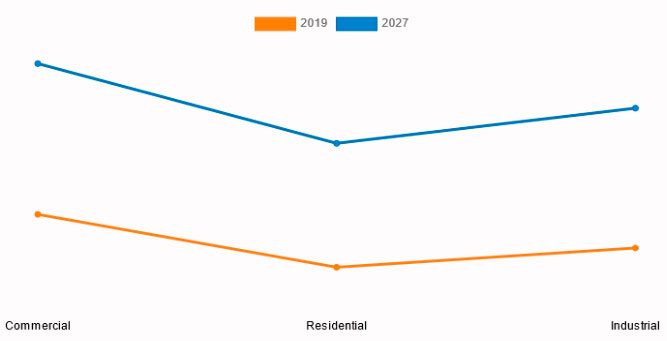

Building Information Modeling Market Statistics: 2027
Source: https://www.alliedmarketresearch.com/building-information-modeling-market
The global building information modeling market size was valued at $5,205 million in 2019, and is projected to reach $15,892 million by 2027, registering a CAGR of 15.2% from 2020 to 2027.
Building information modeling (BIM) is a type of software used by real estate companies; construction firms; and architecture, engineering, and construction (AEC) professionals for effective project life cycle management.
The key objective of building information modeling software is to enhance project performance and produce better outcomes.
BIM helps construction managers to gather data and information from relevant disciplines and communicate more effectively.
Enhanced data communication and coordination among various stakeholders coupled with improved construction productivity provides a leading edge to BIM users.
“The COVID-19 outbreak has low impact on the growth of the building information modeling market as the lockdown during the COVID-19 has enabled wide adoption of BIM to allow projects to continue in a virtual and digital environment even when participants were unable to meet in person. The pandemic has forced to find safer and smarter ways for building offices and homes.”
On the basis of component, the solution segment dominated the overall building information modeling market in 2019, and is expected to continue this trend during the forecast period.
This is attributed to increase in adoption of building information modeling solutions among the AEC industry.
Most of these organizations have started adopting these solutions to align all construction processes together such as procurement and data management, which improve the overall productivity of construction projects.
However, the services segment is expected to witness highest growth, as over past few years, owing to increase in the adoption of services among end users, as they ensure effective functioning of BIM software and platforms.
Furthermore, surge in demand for cloud-based building information modeling services is expected to provide lucrative opportunities for the market growth during the forecast period.
Depending on deployment mode, the on-premise segment dominated the building information modeling market share in 2019, and is expected to continue this trend during the forecast period.
The growth of the segment is attributed to rise in concerns about security of data associated with construction projects, which is highly valuable.
Larger firms in the AEC industry such as Autodesk Inc. and Nemetschek AG provide on-premise software for their customers in industrial, healthcare, and residential sectors.
However, the cloud segment is expected to witness highest growth in the upcoming years, as the cloud-based building information modeling solution does not involve capital cost as well as is low in maintenance requirements, and hence can be most preferred by mid-sized institutions.
Rise in adoption of cloud-based building information modeling solution among both large and mid-sized enterprises majorly drives the market growth.
North America dominates the BIM market size, owing to the ongoing technological advancements in products offered by players operating in the market, supportive government policies, increasing environment awareness, and growing real estate industry.
With rise in rate of real estate in retail, healthcare, entertainment, and industrial sectors, these businesses are finding it difficult to integrate multiple services during the process of planning, designing, and construction.
However, Asia-Pacific is expected to exhibit highest growth during the forecast period, as the adoption of BIM technologies is prominent in this region, owing to the booming construction sector.
Surge in the retail sector as well as development in infrastructure in the region are expected to be the key factors facilitating the growth of the building information modeling market.
Building Information Modeling Market
By Deployment Mode

Cloud-based deployments are projected as one of the most lucrative segments.
The report focuses on the growth prospects, restraints, and building information modeling market analysis.
The study provides Porter’s five forces analysis of the building information modeling industry to understand the impact of various factors such as bargaining power of suppliers, competitive intensity of competitors, threat of new entrants, threat of substitutes, and bargaining power of buyers on the building information modeling market trends.
Segment review
The global building information modeling market is segmented into component, deployment model, project life cycle, building type, application, end user, and region.
In terms of component, the market is bifurcated into solution and services.
Depending on deployment model, it is fragmented into on-premise and cloud. By project life cycle, it is segregated into preconstruction, construction, and operations.
In terms of building type, it is differentiated into commercial, residential, and industrial.
The applications covered in the study include planning & modelling, construction & design, asset management, building system analysis & maintenance scheduling, and others.
As per end user, the market is divided into architects/engineers, contractors, and others. Region wise, it is analyzed across North America, Europe, Asia-Pacific, and LAMEA.
Building Information Modeling Market
By Building Type
Residential buildings are projected as one of the most lucrative segments.
COVID-19 impact analysis
The COVID-19 pandemic has brought radical changes to daily lives of the people, work, and the surrounding environment.
According to the building information modeling market forecast, the current estimation of 2027 is projected to be higher than pre-COVID-19 estimates.
The COVID-19 outbreak has low impact on the growth of the BIM market size as the lockdown during the COVID-19 has enabled wide adoption of BIM to allow projects to continue in a virtual and digital environment even when participants were unable to meet in person.
The pandemic has forced to find safer and smarter ways for building offices and homes.
This global public health crisis has confirmed the significant demand for new ways of building offices and homes, using smart construction to tackle design problems, outdated techniques, inefficiency, and environmental challenges.
For instance, when the lockdown measures were announced in response to the virus outbreak, Cox Architecture, one of the largest architectural practices in Australia, quickly enabled its staff to work from home by providing VPN access to its Autodesk AEC collections. In addition, it increased its investment in BIM360 design for cloud-enabled Revit work sharing.
Top impacting factors
The growth of the global building information modeling market is driven by the fact that the enhanced data communication and coordination among various stakeholders coupled with improved construction productivity provides a leading edge to BIM users.
In addition, rise in government mandates for BIM usage across the globe and expansion of the construction industry fuel the growth of the market.
However, high cost of the software and limitation of the trained professionals hamper the growth of the market.
On the contrary, technological advancements to manage data at remote servers and improvised inter-coordination between users using cloud-based solutions are expected to provide lucrative opportunities for the growth of the market during the forecast period.
Building Information Modeling Market
By Application
Asset Management segment is one of the most significant segments.
Government mandates for BIM usage
Policies and regulations implemented by governments for the deployment of BIM solutions in construction of public and private infrastructure across different regions foster the growth of the BIM market.
In North America, in most countries, the use of BIM for commercial projects has been made mandatory. Moreover, the UK Government proposed a mandate for BIM level 2 for all government projects after April 4, 2016.
In addition, countries, such as Singapore and the UAE, have regulations with respect to the usage of BIM in infrastructure, industrial, and commercial projects.
Furthermore, Germany is working to make BIM mandatory in all infrastructure projects by the end of 2020, while Denmark, Spain, and Italy reached 100%, 93%, and 82%, respectively.
Thus, implementation of positive government policies encouraging the use of BIM is one of the major growth drivers of the BIM market, globally.
Emergence of virtual reality (VR) and augmented reality (AR) technologies and their integration with BIM
In the construction industry, technologies and processes that support BIM are constantly evolving.
Increase has been witnessed in the trend of BIM integration with AR/VR where users visualize a virtual world and can interact with it.
Increase in popularity of BIM integration with AR/VR is opportunistic for the market growth, as it improves communication among stakeholders and provides better visualization for designers, engineers, and other stakeholders, enabling one-to-one fully immersive experience.
In addition, to address some of the inherent deficiencies of BIM and to open a new area for enhancement in the AEC industry, researchers have proposed the use of new technologies such as AR and VR. AR/VR technologies can potentially enhance BIM in several aspects, such as real-time on-site communication, thus providing potential growth opportunities for the market.
Building Information Modeling Market
By Region

Asia-Pacific region is projected as one of the most significant segments.
Key Benefits For Stakeholders
- – This study includes the building information modeling market analysis, current trends, and future estimations to determine the imminent investment pockets.
- – The report presents information related to key drivers, restraints, and building information modeling market opportunity.
- – The building information modeling market size is quantitatively analyzed from 2019 to 2027 to highlight the financial competency of the industry.
- – Porter’s five forces analysis illustrates the potency of buyers & suppliers in building information modeling market.
Key Market Segments.
* By Component
– Solution
– Service
* By Deployment Mode
– On-premise
– Cloud
* By Project Life Cycle
– Preconstruction
– Construction
– Operations
* By Application
– Planning & Modelling
– Construction & Design
– Asset Management
– Building System Analysis & Maintenance Scheduling
– Others
* By Building Type
– Commercial
– Residential
– Industrial
* By End User
– Architects/Engineers
– Contractors
– Others
* By Region
– North America
U.S.
Canada
– Europe
UK
Germany
France
Russia
Italy
Rest of Europe
– Asia-Pacific
China
Japan
India
South Korea
Singapore
Rest of Asia-Pacific
– LAMEA
Latin America
Middle East
África
Key Market Players
* Autodesk, Inc.
* Asite Solution
* Beck Technology Ltd.
* Bentley Systems, Incorporated
* AVEVA Group Plc.
* Dassault Systèmes
* Hexagon AB
* Nemetschek SE
* Pentagon Solution Ltd.
* Trimble Ltd.



